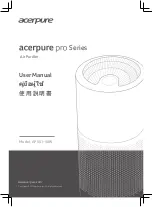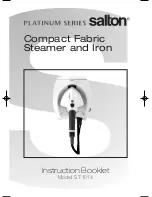
10/2018
- 10 -
Copyright © 2018, Fast ČR, a.s.
INSERTING AND REMOVING RECHARGEABLE BATTERY
■
Before first use, it is necessary to install the included Li-Ion battery
B3
(14,4 V ,
2850 mAh) into the robotic vacuum cleaner. Use only the original battery type.
■
Turn the vacuum cleaner upside down. Check that switch
A20
is set to position
0 (off). Screw out the screws from the cover
A24
and remove the cover
A24
,
see figure I.
■
Connect the connector located in the battery compartment to the battery
B3
,
see figure J. The battery
B3
can be connected in only one direction. Put the
battery
B3
into the battery compartment and close the battery compartment
with the cover
A24
. In the front part of the cover
A24
there are tabs that must
first slide into the grooves in the battery compartment, and only then is it
possible to close the cover
A24
and attach it by screwing in the screws. After
attaching the cover
A24
, turn the robotic vacuum cleaner back over to the
operating position.
■
Remove the battery
B3
in reverse sequence. Before removing the battery
B3
,
check that switch
A20
is set to position 0 (off).
■
When the robotic vacuum cleaner will not be used for an extended period of
time, take out the battery
B3
and store it in a dry, clean and cool place out of
children’s reach.
LOCATION AND USE OF THE CHARGING STATION
■
Locate the charging station
B1
against a wall on a hard, even and dry surface
within reach of a power socket. Make sure that there are no stairs or obstacles
within a range of 1.5 m, that would prevent the robotic vacuum cleaner from
finding the charging station
B1
and docking successfully.
■
Insert the power adapter cable connector into socket
C2
of the charging
station
B1
, and insert the power cord plug into a power socket.
■
After connecting to a power socket, the indicator light
C1
will be lit indicating
the connection of the charging station
B1
to a power source.
■
When the robotic vacuum cleaner detects low voltage of the battery
B3
during
operation, it will automatically start to search out the charging station
B1
. In
order for the robotic vacuum cleaner to find the charging station
B1
and to
dock into it, it needs to locate the infrared signal transmitted by the charging
station
B1
. For this reason, we recommend leaving the charging station
B1
permanently connected to a power source. When the robotic vacuum cleaner
docks inside the charging station
B1
, the charging cycle will commence and
the charging station
B1
will stop transmitting the infrared signal.
■
In the event that the robotic vacuum cleaner is not used for an extended
period of time, disconnect the charging station
B1
from the power socket and
store it in a dry, clean and cool place.
CHARGING RECHARGEABLE BATTERY
■
To charge the battery
B3
, it is necessary to dock the robotic vacuum cleaner
into the charging station
B1
. You may do this manually or allow the robotic
vacuum cleaner to dock automatically.
■
Make sure that the charging station
B1
is connected to a power socket. This is
signalled by indicator light
C1
being lit. Set the switch
A20
on the underside of
the robotic vacuum cleaner to position I (on).
■
For manual docking, put the robotic vacuum cleaner into the charging station
B1
so that the charging contacts
A26
on the underside of the robotic vacuum
cleaner connect with the charging contacts
C5
on the charging station
B1
.
When the contacts are connected, the charging process will start. The control
button LED indicator light
A9
will slowly flash red.
■
For automatic docking into the charging station
B1
, set the return to charging
station mode using button
D10
on the remote control
B4
. When the signal
from the remote control
B4
is received, the robotic vacuum cleaner will emit an
acoustic signal and commence to automatically seek out the charging station
B1
.
■
Likewise, the robotic vacuum cleaner will start seeking out the charging
station
B1
when the voltage on the battery
B3
falls below a certain level.
■
When the vacuum cleaner returns to the charging station
B1
, the control
button LED indicator
A9
will be lit red. The navigation and anti-collision
infrared signals transmitted by the charging station
B1
are used for the
navigation and successful docking of the robotic vacuum cleaner.
■
When the robotic vacuum cleaner finds the charging station
B1
and manages
to dock, the charging process will commence. The transmitter of the navigation
and anti-collision infrared signal
C3
and
C4
will stop transmitting the signal.
The control button LED indicator light
A9
will slowly flash red.
■
When the battery
B3
is fully charged, the charging process will stop
automatically. The control button LED indicator light
A9
will slowly flash green.
■
A complete charge takes approximately 3 to 5 hours. The actual charging time
depends on the power level of the battery
B3
. A fully charged battery
B3
will
provide up to 80 minutes of operation. Allow the battery
B3
to fully charge
before first use.
■
In the event that the charging contacts are disconnected during the charging
cycle, the robotic vacuum cleaner will move away from the charging station
B1
and then redock itself to resume the charging process, unless it is prevented
from doing so by an obstacle.
■
In the event of a power outage, the charging cycle will be interrupted and will
continue after the power supply is renewed.
■
In the event that the maximum charging current is exceeded, the charging
station
B1
will automatically interrupt the charging cycle.
■
A fault on the charging station
B1
is signalled by a quickly flashing indicator
light
C1
.
RECHARGEABLE BATTERY CARE
■
We recommend that you do not interrupt the charging cycle and to maintain
the battery
B3
in a charged state.
■
Do not leave the robotic vacuum cleaner standing fully charged or completely
flat for an unnecessarily long period of time.
■
A battery that is allowed to remain flat for a long time may self-discharge
below a permissible level and thereby cause irreparable damage to itself.
TURNING THE ROBOTIC VACUUM CLEANER ON AND OFF
■
Turn on the power supply to the robotic vacuum cleaner by setting switch
A10
to position I (on). In the event that the vacuum cleaner is located away from
the charging station
B1
, when switch
A20
is set to position I (on), it will switch
to the stand-by mode. In the event that the vacuum cleaner is docked in the
charging station
B1
, when switch
A20
is set to position I (on), the charging
process will start automatically.
■
Turn off the power supply to the robotic vacuum cleaner by setting switch
A20
to position 0 (off). The control button LED indicator light
A9
will turn off. When
the vacuum cleaner is turned off, it is not possible to control it using the control
button
A9
or the remote control
B4
.
STAND-BY MODE AND SLEEP MODE
■
In the stand-by mode, the control button LED indicator
A9
is lit green. After
one minute of inactivity, an acoustic signal is emitted and the robotic vacuum
cleaner automatically switches to sleep mode.
■
In the sleep mode, the control button LED indicator
A9
quickly flashes green in
5-second intervals. To wake the robotic vacuum cleaner from the sleep mode
into the stand-by mode, press control button
A9
once. A sound is made and
the control button LED indicator
A9
will be lit green.
USING THE CONTROL BUTTON
■
The control button
A9
serves to wake up the robotic vacuum cleaner from
sleep mode, to put the robotic vacuum cleaner into the automatic cleaning
mode and to stop its operation.
■
To wake the robotic vacuum cleaner from the sleep mode into the stand-
by mode, press control button
A9
once. Waking up from the sleep mode is
confirmed by an acoustic signal.
■
To put the robotic vacuum cleaner into operation from the stand-by mode
or from the charging mode, press the control button
A9
once. The robotic
vacuum cleaner will start automatic cleaning.
■
To stop operation, press the control button
A9
once. An acoustic signal will
be emitted and the robotic vacuum cleaner will switch to the stand-by mode.
After one minute of inactivity, an acoustic signal is emitted again and the
robotic vacuum cleaner automatically switches to sleep mode.
USING THE REMOTE CONTROL
■
The signal range of the remote control
B4
is 6 m. If the vacuum cleaner is
located outside the signal range, it will not be transmitted.
BUTTON
■
Button
D7
serves to put the robotic vacuum cleaner into the automatic
cleaning mode and to stop its operation.
■
To put the robotic vacuum cleaner into operation, press button
D7
once. The
robotic vacuum cleaner will switch to the automatic cleaning mode.
■
To stop operation, press button
D7
once. An acoustic signal will be emitted
and the robotic vacuum cleaner will switch to the stand-by mode. After
one minute of inactivity, an acoustic signal is emitted again and the robotic
vacuum cleaner automatically switches to sleep mode.
BUTTON
■
When button
D17
is pressed, the robotic vacuum cleaner will emit an acoustic
signal. This function can be utilised when, for example, you need to find out
in which room the vacuum cleaner is currently located. When button
D17
is
released, the robotic vacuum cleaner will stop emitting the acoustic signal.
MODE SELECTION BUTTON
■
Button
D10
serves to set the automatic cleaning mode, along-the-wall
cleaning mode, spiral cleaning mode or return back to the charging station
and charge mode.
■
When the robotic vacuum cleaner is in the stand-by mode, sleep mode or
charging, press button
D10
to automatically start the automatic cleaning
mode. Repeatedly press button
D10
to switch between the individual
operating modes in the order shown in figure K. The mode setting is indicated
by the respective indicator on display
D1
on the remote control
B4
.































